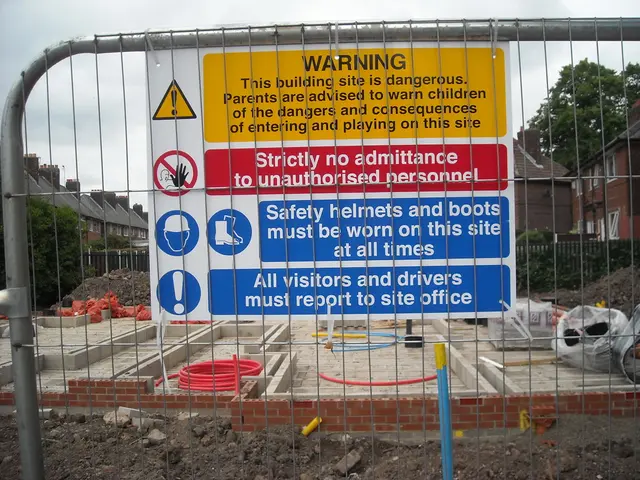Reimagining Vacant Downtown L.A. Skyscraper Spaces for Housing Solutions to Alleviate the Crysis
Transforming Downtown Los Angeles Office Towers into Housing: A Potential Solution to the Housing Shortage
Downtown Los Angeles (LA) is on the brink of a significant transformation as aging office towers are being considered for conversion into deluxe apartments. This redevelopment could help address the city's housing shortage by adding thousands of residential units in a high-demand urban area, where apartment occupancy exceeds 90%.
According to a study by BAE Urban Economics, converting just 10 large office buildings downtown could create over 3,800 new housing units, raise combined asset values by $12 billion, and increase annual property tax revenue by approximately $46 million [2][4]. This reuse of underutilized space in high-vacancy office buildings, particularly post-pandemic, would transform them into competitive apartments with attractive features such as high ceilings and sweeping city views [2][4].
To encourage developers to undertake these conversions, experts and business groups are advocating for financial incentives from the city. Suggested incentives include tax breaks or credits to offset redevelopment costs, streamlined permitting and approvals to speed project timelines, support to offset demolition and build-out expenses, and potential public-private partnerships or subsidies to reduce financial risk [4].
In the last decade, 22% of the new housing in the city has been built downtown, where city planning policies encourage dense development. Many early 20th century office buildings have already been converted to apartments and hotels, but newer generation towers are now being considered. The nearly 40-year-old 777 Tower, designed by architect César Pelli, is an attractive candidate for conversion due to its retail complex at the base [2][4].
The 777 Tower, completed in 1991, has separate banks of elevators for different tiers of floors, which could make it easier to convert some floors to housing while others remain offices. Meanwhile, the city is close to adopting a new building code that will make it easier for developers to get approvals to convert offices built after 1975.
Los Angeles County officials have declared that the Gas Company Tower is seismically safe, but are reviewing bids to perform more than $230 million worth of proactive upgrades. Last year, the Gas Company Tower was sold to Los Angeles County for approximately $200 million [2][4].
City leaders should consider offering financial incentives such as those found in other cities to bridge the gap to profitability for private landlords considering conversion. Such incentives could boost tax revenue, providing financial stability for both developers and the city, and alleviate the housing crisis [2][4].
However, the city faces a nearly $1-billion budget shortfall as of May. Elite Financial District towers, previously commanding top rents, are among the suggested targets for conversion due to vacancies caused by the COVID-19 pandemic. The city's office rental market is mired in high vacancies and falling values, making these conversions even more crucial [2][4].
Efforts to convert underused office towers to housing could boost assessed property value and add tax revenue, according to a report commissioned by the Central City Assn. of Los Angeles. The report suggests that the city should consider giving developers financial incentives to convert buildings to help meet LA’s ambitious housing goals while stabilizing downtown’s real estate market.
In summary, converting downtown LA office towers into housing can add thousands of homes in a high-demand area, increase property values and tax income, and alleviate the housing crisis. Financial incentives like tax relief and streamlined processes are critical to motivating developers to pursue these projects. The potential benefits of these conversions extend beyond the housing market, providing a much-needed boost to the city's finances and economic stability.
References: [1] Los Angeles Times. (2021, May 15). Downtown L.A. office towers are being transformed into housing. Here's why. Retrieved from https://www.latimes.com/business/story/2021-05-15/downtown-la-office-towers-are-being-transformed-into-housing-heres-why [2] Curbed LA. (2021, May 18). Downtown LA office towers are being transformed into housing. Here's why. Retrieved from https://la.curbed.com/2021/5/18/22445582/downtown-la-office-towers-housing-conversion-benefits [3] BAE Urban Economics. (2021). Converting downtown LA office buildings to housing: The benefits and opportunities. Retrieved from https://www.baeureconomics.com/resources/converting-downtown-la-office-buildings-to-housing-the-benefits-and-opportunities [4] KPCC. (2021, May 18). Downtown LA office towers are being transformed into housing. Here's why. Retrieved from https://www.scpr.org/news/2021/05/18/994554/downtown-la-office-towers-are-being-transformed-into-housing-heres-why
- The housing shortage in Los Angeles could be alleviated by converting large office buildings in downtown LA into deluxe apartments, as suggested by a study by BAE Urban Economics.
- City leaders might consider offering financial incentives, such as tax breaks or subsidies, to encourage developers to convert underused office towers into housing.
- converting office towers into housing could raise combined asset values by $12 billion and increase annual property tax revenue by approximately $46 million, according to the same study by BAE Urban Economics.
- In the midst of a nearly $1-billion budget shortfall, converting underused office towers could add tax revenue, providing financial stability for both developers and the city.
- The USC and Rams stadiums, along with high crime rates and a reemerging COVID-19 pandemic, could affect the demand for apartments in downtown LA.
- The transformation of downtown LA office towers into housing is not just a solution for the housing shortage but also a potential boon for the city's finances and economic stability.




